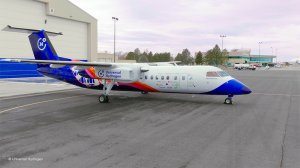IATA releases roadmaps for the route to net-zero carbon emissions aviation by 2050


A De Havilland Canada Dash 8 regional airliner converted into a hydrogen-powered test aircraft by Universal Hydrogen
Photo by Universal Hydrogen
The International Air Transport Association (IATA), which is the global representative body for the airline industry and is currently holding its annual general meeting in Istanbul, Türkiye, has issued five roadmaps to ensure that the industry achieves net-zero carbon emissions status by 2050. Net-zero is the goal of both the industry and governments.
“The roadmaps are the first detailed assessment of the key steps necessary to accelerate the transition to net zero by 2050,” highlighted IATA director-general Willie Walsh. “Together, they show a clear direction and will evolve as we dig deeper to set interim milestones on the way to net zero. I must emphasise that the roadmaps are not just for airlines. Governments, suppliers and financiers cannot be spectators in aviation’s decarbonisation journey. They have skin in the game. The roadmaps are a call to action for all aviation’s stakeholders to deliver the tools needed to make this fundamental transformation of aviation a success with policies and products fit for a net-zero world.”
The process of the development of the roadmaps was accompanied by a peer-to-peer review and complemented by a modelling tool developed by the University College London’s Air Transportation Systems Laboratory. These processes allowed the calculation of the carbon emission cuts that will be provided by each technology.
The five roadmaps are – aircraft (and aeroengine) technology; energy and new fuels infrastructure; operations; policy; and finance.
Regarding aviation technology, manufacturers will have to develop more efficient aircraft and engines. Especially important will be allowing aircraft to be powered by 100% sustainable aviation fuels (SAF), hydrogen, and/or batteries. This roadmap covers aerodynamics, aircraft structures and flight systems as well as new engines. All the development milestones are supported by announced investment and demonstration projects.
The energy and new fuels infrastructure roadmap is focused on the development of infrastructure for new fuels and energy carriers, upstream of airports. This will be essential to allow the adoption of SAF and hydrogen aircraft fuels. The roadmap sets out milestones to promote the required infrastructural development.
The operations roadmap is concerned with reducing carbon emissions by improving the efficiency with which existing airliners are operated. In particular, with the use of automation, big data management and the adoption of new technologies to optimise air traffic management and so increase air transport system efficiency.
The policy roadmap highlights the need for strategic incentives and support policies, for industry’s transition to net-zero, to be globally aligned. For this transition, as was the case with other energy transitions, collaboration between industry and governments will be essential.
Commercial aviation’s transition to net zero by 2050 is expected to involve a cumulative cost of $5-trillion, for the development of infrastructure, improvements in operations and technology advances. The finance roadmap is focused on how to provide this funding.
“Without the right policy incentives and bold investments, many of the technologies and innovations simply won’t happen at scale,” stressed IATA senior VP: sustainability and chief economist Marie Owens Thomsen. “Everything is related, and that is why we have the five roadmaps to tie all the parallel elements together and give our stakeholders, including governments, a complete understanding of everything that needs to happen.”
Comments
Press Office
Announcements
What's On
Subscribe to improve your user experience...
Option 1 (equivalent of R125 a month):
Receive a weekly copy of Creamer Media's Engineering News & Mining Weekly magazine
(print copy for those in South Africa and e-magazine for those outside of South Africa)
Receive daily email newsletters
Access to full search results
Access archive of magazine back copies
Access to Projects in Progress
Access to ONE Research Report of your choice in PDF format
Option 2 (equivalent of R375 a month):
All benefits from Option 1
PLUS
Access to Creamer Media's Research Channel Africa for ALL Research Reports, in PDF format, on various industrial and mining sectors
including Electricity; Water; Energy Transition; Hydrogen; Roads, Rail and Ports; Coal; Gold; Platinum; Battery Metals; etc.
Already a subscriber?
Forgotten your password?
Receive weekly copy of Creamer Media's Engineering News & Mining Weekly magazine (print copy for those in South Africa and e-magazine for those outside of South Africa)
➕
Recieve daily email newsletters
➕
Access to full search results
➕
Access archive of magazine back copies
➕
Access to Projects in Progress
➕
Access to ONE Research Report of your choice in PDF format
RESEARCH CHANNEL AFRICA
R4500 (equivalent of R375 a month)
SUBSCRIBEAll benefits from Option 1
➕
Access to Creamer Media's Research Channel Africa for ALL Research Reports on various industrial and mining sectors, in PDF format, including on:
Electricity
➕
Water
➕
Energy Transition
➕
Hydrogen
➕
Roads, Rail and Ports
➕
Coal
➕
Gold
➕
Platinum
➕
Battery Metals
➕
etc.
Receive all benefits from Option 1 or Option 2 delivered to numerous people at your company
➕
Multiple User names and Passwords for simultaneous log-ins
➕
Intranet integration access to all in your organisation


















